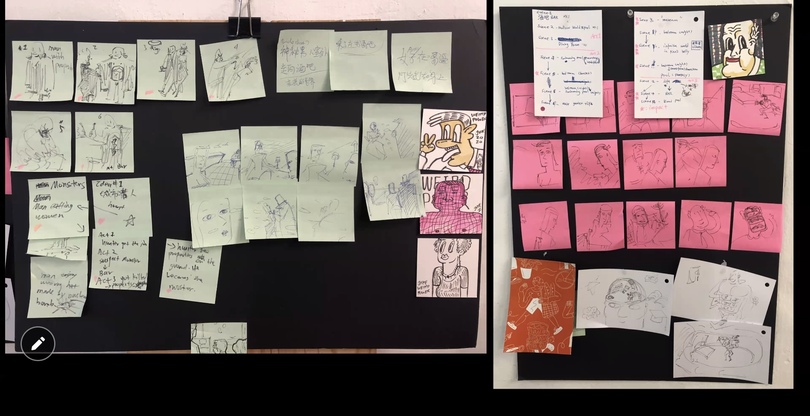Animation artist Junjie Zhang outlines creative production process to VPA seniors

Screenshot from Zoom
During the talk, Zhang broke down his creative processes for storyboarding and animation to students for students using examples from one of his recent short films
Get the latest Syracuse news delivered right to your inbox.
Subscribe to our newsletter here.
From Hong Kong, Junjie “Jake” Zhang spoke to Syracuse University students over Zoom on Wednesday morning. His lecture focused on his directorial work for “Blood Swim,” an animated short film that came out earlier this year. Using his work to frame the discussion, he offered students a step-by-step guide on how to create their own animated shorts, from the planning stages to post-production.
“When storyboarding, ask yourself: Are you more of a visual-driven artist?” Zhang said. “There’s no good or bad for this one, especially in pre-production. Creating the concept (for a story) is more like taking notes, getting the most interesting moments from your mind.”
Zhang is an award-winning independent animation artist. He’s garnered numerous awards and recognition for his animated short films, most recently winning international distinctions for his 2016 short film “Pokey Pokey.” The animator has expanded his career into the world of education, now serving as an assistant professor of practice in digital arts at the Hong Kong University of Science and Technology.
Even though Zhang’s event was open to all SU students, it was aimed at a particular audience: Professor Rebecca Ruige Xu’s CAR 430 Computer Art Seminar class, which sat in on the lecture. The seminar is for College of Visual and Performing Arts seniors majoring in computer art and animation, intending to prepare them for their senior theses of creating animated short films. Zhang’s lecture served as a guide in their pre-production planning.
Zhang angled his talk in an informative way, outlining his filmmaking process. He discussed his creative process from mystery to certainty to illustrate what students should strive for in their projects. The artist posed three questions to students developing their story concepts: “What is it? How does it look? What is it made of?”
“Embrace the randomness … Amplify, so the audience can fully immerse in the story,” Zhang said.
After establishing those questions, the artist offered the audience a look at “Blood Swim.” He played the eight-minute short film, which he used to begin his lecture, explaining how he answered the same questions he had posed to the audience when developing it.
Zhang expanded on his creative process, talking students through his storyboarding methods, which he emphasized are not about the art. Nonetheless, storyboarding is important since it’s the first and most crucial step of what Zhang calls the film production pipeline.
When Zhang storyboards, he focuses on getting his characters’ actions onto paper first and refining the animation later. He first used 2D storyboards and simple animatics to finalize the flow of “Blood Swim” before animating it in greater detail.
“I’m more of a visual-driven type,” Zhang said. “I like to create key moments in my mind that can be included in the final production.”

Zhang told students to “embrace the randomness,” when outlining an animated film.
Screenshot from Zoom
He emphasized the importance of story and camera placement while developing storyboards, stressing that until the storyboards are executed to the director’s vision, the rest of the project won’t be able to proceed.
“You’re creating a space according to the story and … making a decision for the best choice for shooting the scene,” Zhang said. “In your mind, there should be three-dimensional thinking … you’re picking the best one according to the need to tell the story.”
Zhang’s biggest advice regarding animation was for aspiring directors to clearly outline what they want their outcome to be with character design, mainly because the director is not typically the one to animate during a project.
Toward the end of his talk, Zhang offered practical advice on how to make a film during the pandemic. Although it’s possible, it’s challenging, especially with an international team, he said. He underscored the importance of organization and provided attendees with the methods he uses to keep his work in order.
“As a director, you need to be very clear about the pipeline,” Zhang said. “You need to be very clear that each component has an outcome so you can define time management (for the project).”
He concluded his talk by fielding questions from the audience, most of which came from Xu’s students. Before leaving the Zoom call, Zhang offered a final piece of advice for aspiring filmmakers.
“You have to look back to what is the most interesting part in animation,” Zhang said. “Find the most passionate part … the most interesting part that motivates you to create.”





